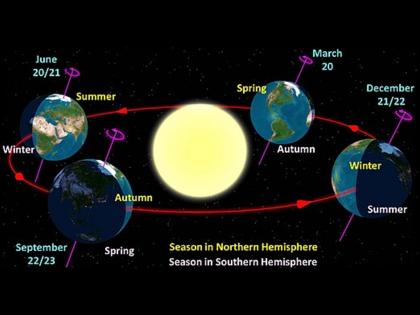Winter Solstice 2024: All You Need to Know About the Shortest Day of the Year
By Lokmat English Desk | Updated: December 21, 2024 12:38 IST2024-12-21T12:37:56+5:302024-12-21T12:38:55+5:30
Days are usually shorter in winter, while nights are longer, as the cold wave sweeps through during these months. ...

Winter Solstice 2024: All You Need to Know About the Shortest Day of the Year
Days are usually shorter in winter, while nights are longer, as the cold wave sweeps through during these months. As we approach Christmas and the winter holidays, the shortest day of the year, known as the Winter Solstice, is just around the corner.
What Is a Solstice?
A solstice occurs when the Sun reaches its farthest northern or southern point relative to the celestial equator on the celestial sphere. There are two solstices each year, typically around 20–22 June and 20–22 December. In many countries, the seasons are marked by referencing the solstices and equinoxes.
What Is the Winter Solstice?
The Winter Solstice, also known as the Hibernal Solstice, happens when one of Earth's poles is tilted at its maximum distance away from the Sun. This occurs twice annually, once in each hemisphere (Northern and Southern). In the affected hemisphere, the Winter Solstice is the day with the shortest daylight period and longest night of the year. During this time, the Sun reaches its lowest daily maximum elevation in the sky.
The shortest day and the longest night of the year are here! #DidYouKnow what is the Winter Solstice, which occurs on December 21? @laughterwidravi tells you about this day!#WinterSolsticepic.twitter.com/n1UzhCpsul
— DD News (@DDNewslive) December 21, 2024
Each polar region experiences continuous darkness or twilight during its Winter Solstice. While the solstice itself lasts only a moment, the term also refers to the entire day it occurs. In many temperate regions, the Winter Solstice is often seen as the midpoint of winter.
When Does It Occur?
According to NASA, the Winter Solstice in 2024 will take place on December 21 at around 4:20 AM ET. This marks the beginning of winter in the Northern Hemisphere and summer in the Southern Hemisphere.
For those living north of the equator, this day will feature the least amount of sunlight. The amount of daylight depends on your location. For instance, places farther north, such as Alaska, will experience minimal sunlight, while areas farther south, like Florida, will have slightly more daylight.
Locations north of the equator will see daylight shorter than 12 hours, while those south of the equator will experience daylight longer than 12 hours, as per a NASA study.
History and Significance of the Winter Solstice
The Winter Solstice has held cultural and agricultural significance for many societies throughout history. It symbolises the reversal of shortening daylight hours and the start of longer days. In European cultures, it was often associated with the symbolic death and rebirth of the Sun. Many ancient monuments, such as Newgrange, Stonehenge, Cahokia Woodhenge, and Ahu Tongariki, are aligned with the sunrise or sunset on the Winter Solstice.
Also Read | 22 December to have the longest night and shortest day of 10.47 hours, as per astronomy experts.
The solstice also influenced farming activities, such as the sowing of crops and monitoring of stored food supplies. For some animals, it marked the mating season. Historically, animals were slaughtered during this time to reduce the burden of feeding them through the winter months.
Celebrations Around the World
The Winter Solstice has inspired festivals and traditions across the globe, many of which continue to be celebrated today:
Saturnalia (Rome): This ancient Roman festival honours Saturn, the god of agriculture. Originally a one-day event, it later expanded into a week-long celebration.
Dongzhi (China and East Asia): This festival celebrates the return of longer days and positive energy, rooted in the yin and yang philosophy of balance and harmony.
Yaldā (Persia): Marking the last day of the Persian month of Azar, this festival celebrates the triumph of light over darkness and honours Mithra, the sun god.
Inti Raymi (Peru): Dedicated to Inti, the Incan sun god, this festival involved fasting for three days before the solstice and gathering to watch the sunrise.
Yule (Europe): A pagan tradition that includes creating an altar with items symbolising joy and peace, surrounded by candles.
Soyal (Hopi Nation): This tradition honours kachina (ancestral spirits of the natural world) through rituals, dances, prayers, singing, and storytelling.
Burning the Clocks (Brighton, UK): A modern lantern parade celebrating the solstice with art and community spirit.
The Winter Solstice is more than an astronomical event; it carries cultural, historical, and symbolic significance that continues to unite people worldwide in celebration of light, hope, and renewal.
Open in app